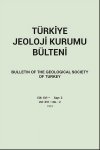
-
2025
-
2024
-
2023
-
2022
-
2021
-
2020
-
2019
-
2018
-
2017
-
2016
-
2015
-
2014
-
2013
-
2012
-
2011
-
2010
-
2009
-
2008
-
2007
-
2006
-
2005
-
2004
-
2003
-
2002
-
2001
-
2000
-
1999
-
1998
-
1997
-
1996
-
1995
-
1994
-
1993
-
1992
-
1991
-
1990
-
1989
-
1988
-
1987
-
1986
-
1985
-
1984
-
1983
-
1982
-
1981
-
1980
-
1979
-
1978
-
1977
-
1976
-
1975
-
1974
- 1973
-
1972
-
1971
-
1970
-
1969
-
1968
-
1966
-
1964
-
1963
-
1961
-
1959
-
1958
-
1955
-
1954
-
1953
-
1952
-
1951
-
1950
-
1949
-
1948
-
1947
Abstract: This paper presents a study of shear deformation whichincludes a theoretical approach to progressive - retrogressive failure,involving discontinuous, elastic-elatoplastic finite element method.It has been concluded that choice of boundary conditions exertd an important control on failure mechanism. Under certain boundary conditions,the ultimate failure of the test block is a consequence of multiple fracturemode. "In-situ" shear tests on geological materials should be interpretedin more sophisticated terms; i.e., as a consequence of variable combinedstress state, involving inhomogeneous stress field, one / several of principal stresses being tensile; extensive stress reorientation; multiplecrack propagation. The theoretical approach to the mechanism of sheardeformation. The theoretical approach to the mechanism of shear deformation failure characteristics of "ın-situ" shear tests, utilizing finiteelement method, appears to be a valid approach for prediction of certainexperimental results.
Abstract: Çaltepe Limestone, Seydişehir Formation which are known from Seydişehir area (Northern Central Taurus) crop out also near Hadim, (Konya) through a tectonic fenster. In this latter locality dark colored shales, unknown from Seydişehir area, form the basal part of the sequence. The sequence ther is overturned the shales are seen above Çaltepe Limestone along Göksu valley. Arenigian trilobites were found in Seydişehir Formation in Seydişehir atea (Dean, Monod, 1970). The same formation yielded Upper Cambrian (Hertzina bisulcata, Oneotodus tenuis, Oneotodus gallatini, Acodus cambricus) , Lower Ordovician (Drepanodus homocurvaltus, Drepanodus planus )conodonts,d Acrotretid brachiopoda in Hadim area where these Lower Paleozoic rocks are directly uncomformably overlain by Upper Jurassic-Cretaceous limestones. Lower Paleozoic of Central, Eastern Taurus, of Southeastern Anatolia, of Amanos mountains exhibit very similar stratigraphical, lithological characteristics.
Abstract: Some relations between the photographic appearance the physical characteristics of the Carboniferous Limestone were found, consequently a better understanding could be obtained in a limestone terrain.
Abstract: Maestrichtian - Paleocene Foraminifera of the Cide Region (Central Northern Turkey) is shortly discussed, a new Cuvillierina species from the same area is described.
Abstract: In 1968, the team of vertebrate Paleontology of M.T.A. discovered a part of a cranium some horn-cores of Gazella deperdita Gerxmis (Syn. G. brevicornis), several horn-cores of Palaeoreas lindermayeri Gaudry a many Mammalian fossil remains in Külâhlıayağı site of Gülpınar (Çanakkale).
Numerous specmens of Palaeoreas lidermayeri Gaudry, Gazella deperdita Gervais was found m the exploration, excavation of the different place of Anatolia until to day. The first discovering of Gazella deperdita Gervais, Palaeoreas litodermayeri Gaudry in Dardanelles province is very important for the stratigraphie correlation of this site with Anatolia localities, the other sites in Europe, Asia. Thus, we will have much knowledge for faunal migration the region of dispersion between Gülpınar the other localites of Anatolia, Asia, Europe.
Formerly, Choerolophodon, Hipparion, Palaeotragus, Helladotherium was found on this region. Now, Palaeoreas lindermayeri Gaudry, Gazella deperdita Gervais have added to these Mammaliam fauna. The last two specks belong to steppe fauna. The stratigraphic position of the locality had been clearly outlined by adding the new evidence to the early fauna. For this reason, these two fossils are very much important for Dardanelles.
These fossils indicate for this locality an age of middle level of Pontian (lower Pliocene).
Abstract: The ohispherites, are characterized by their associationwith the serpentinites. These roumded inclusions of an avarage diameterof 5-15 centimeters are to be considered as the result of the fragmentation of pre-existing diabase dikes affected by a subsequent differential chlontizatiom. They are generally formed by an external a centralzone exhibiting a distinctily different mineralogical, chemical composition.The chloritization, the Resulting concentric zonation of theseophispherites in due to the circulation of magnesium-rich water solutions.These meta-somatic processes took place in the two following stages:1) In a first stage only the plagioclase is transformed in chlorite(pennine). As calcium, silicon are removed from the plagioclas, secondary clinozoisite, some zoisite are formed.2) Subsequently, the amphibole, a magnesian member of the ferroactinolitetremolite series, is changed in chlorite (clinochlore).The intensity of chloritization varies considerably from one ophispherite to another. It can be explamed by the variation of pressure, temperature conditions, the velocity of the circulating aqueous solutions,the texture of the primary rock, its mineralogical composition as well asthe size of the fragments of pre-existing diabase dykes.

 TMMOB
TMMOB